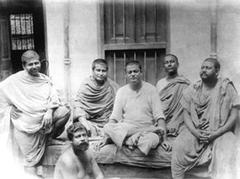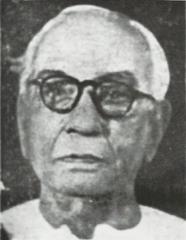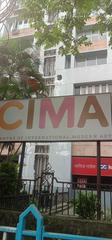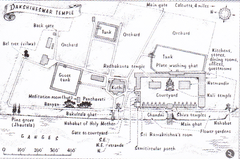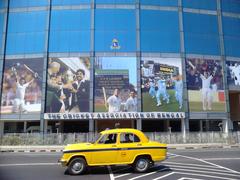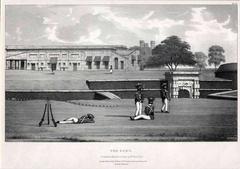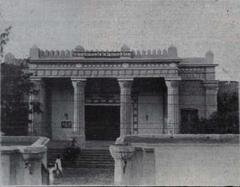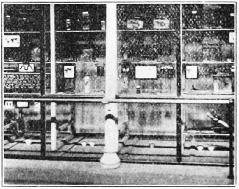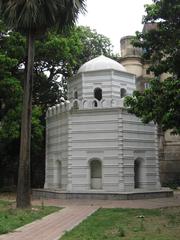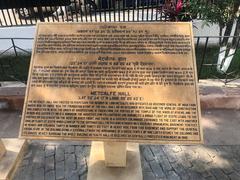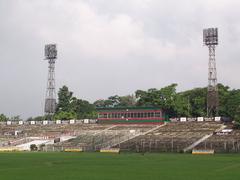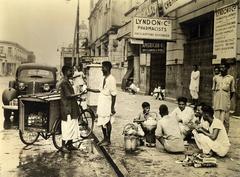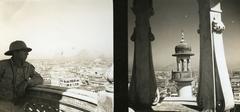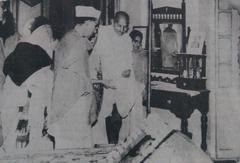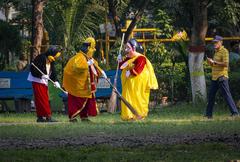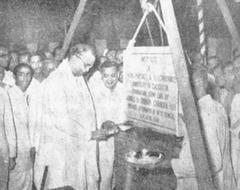Rabindra Sadan Kolkata: Visiting Hours, Tickets, and Historical Significance
Date: 15/06/2025
Introduction
Nestled in the heart of Kolkata’s thriving cultural district, Rabindra Sadan is a premier venue dedicated to the celebration of Bengali heritage and the artistic legacy of Nobel laureate Rabindranath Tagore. Established in the early 1960s, this iconic complex seamlessly integrates modernist architecture with traditional Bengali motifs, symbolizing Bengal’s vibrant intellectual life. Beyond being a performance hall, Rabindra Sadan forms the nucleus of a larger cultural ecosystem, surrounded by institutions such as Nandan, the Paschimbanga Bangla Akademi, Sisir Mancha, and the Academy of Fine Arts. These collectively foster an immersive environment for literature, cinema, theatre, and the visual arts.
Visitors to Rabindra Sadan enjoy not only a rich cultural program—including classical music, dance, theatre, and film—but also convenient access to other significant landmarks like Victoria Memorial, St. Paul’s Cathedral, and Maidan park. The venue is celebrated for its accessibility, visitor-friendly facilities, and central location, making it an essential stop for art lovers, history enthusiasts, and travelers alike. For detailed visitor information, event schedules, and ticketing, consult sources like Incredible Asia and Kolkata Tourism.
Table of Contents
- Introduction
- Origins and Historical Development
- Architectural and Artistic Features
- Main Auditorium and Performance Spaces
- The Rabindra Sadan Cultural Complex
- Role in Bengali Theatre and Performing Arts
- Signature Events and Festivals
- Visitor Information: Hours, Tickets, Accessibility
- Getting There and Location
- Facilities and Accessibility
- Nearby Attractions and Travel Tips
- Outdoor Spaces and Artistic Ambience
- Preservation of Tagore’s Legacy
- Social and Political Context
- Maintenance and Renovations
- Practical Tips for Visitors
- FAQ
- Conclusion and Call to Action
- References
Origins and Historical Development
Rabindra Sadan was conceived as a post-independence initiative to honor Rabindranath Tagore and to foster regional cultural identity. Laid in 1960 and inaugurated by Prime Minister Jawaharlal Nehru in 1961, it quickly became a symbol of the Bengal Renaissance, supporting the city’s intellectual and artistic resurgence (incredibleasia.org). Its placement near other cultural institutions was strategic, forming Kolkata’s vibrant arts corridor.
Architectural and Artistic Features
Completed in 1967, Rabindra Sadan boasts a harmonious blend of modernist sensibilities and traditional Bengali aesthetics (Wikipedia). The two-storey structure features clean lines, broad staircases, and stately pillars, projecting grandeur with minimal ornamentation. The lobby and façade are adorned with murals and busts of Tagore and other luminaries, reinforcing the center’s dedication to Bengali culture (Wanderboat). Open spaces inside and landscaped gardens outside encourage gatherings and artistic interaction.
Main Auditorium and Performance Spaces
Rabindra Sadan’s main auditorium is among Kolkata’s largest, seating approximately 1,200 guests (HelloTravel). Engineered for superb acoustics and clear sightlines, it hosts major theatre productions, classical and contemporary music, dance recitals, and film screenings. The stage supports elaborate set designs and large ensembles, while smaller adjoining spaces accommodate workshops, literary readings, and community events (Wanderboat).
The Rabindra Sadan Cultural Complex
Rabindra Sadan anchors a multi-institutional complex central to Kolkata’s artistic scene:
- Nandan: Opened in 1985, Nandan is Kolkata’s leading film and cultural center, famously hosting the Kolkata International Film Festival (KIFF) (Kolkata Tourism).
- Paschimbanga Bangla Akademi: Established in 1986, this body promotes Bengali literature and language through events and workshops.
- Gaganendra Pradarshanshala: A flexible art gallery for exhibitions in various media.
- Sisir Mancha: An intimate auditorium named after dramatist Sisir Kumar Bhaduri, ideal for experimental theatre (Kolkata Tourism).
- Academy of Fine Arts and Nazrul Academy: The former is one of India’s oldest art societies; the latter is dedicated to Kazi Nazrul Islam’s works.
Role in Bengali Theatre and Performing Arts
A cradle for the renaissance of Bengali theatre, Rabindra Sadan has staged landmark productions, from Tagore’s plays to experimental works by contemporary dramatists. It has also been a launchpad for many renowned actors and directors. The hall regularly hosts Rabindra Sangeet concerts, classical Indian music, and dance recitals, making it a dynamic space for tradition and innovation alike.
Signature Events and Festivals
- Kolkata International Film Festival (KIFF): Held every November, with Rabindra Sadan and Nandan as primary venues (AllEvents.in).
- Rabindra Jayanti: Celebrated annually on May 8th, honoring Tagore’s birth with music, dance, and recitals.
- Rabindrotsav: A multi-day festival of Tagorean art, literature, and scholarship.
- Other Events: The venue also hosts children’s film festivals, literary gatherings, classical music and dance programs, and guest performances throughout the year.
Event details and ticketing are available via AllEvents.in and the official tourism portal.
Visitor Information: Hours, Tickets, and Accessibility
- Visiting Hours: Typically open daily from 10:00 AM to 9:00 PM (may vary by event).
- Tickets: Entry is free for visitors, but performances and screenings require tickets (₹50–₹500 depending on the event). Advance booking is recommended during festivals.
- Accessibility: The venue is wheelchair accessible, with ramps and reserved seating. Restrooms and cloakrooms are available, and staff provide visitor assistance.
- Guided Tours: Can be arranged by prior appointment, focusing on history and Tagore’s legacy.
- Getting There: Located on A.J.C. Bose Road, adjacent to Rabindra Sadan Metro Station. Buses, taxis, and rideshares are readily available. Limited paid parking exists but public transport is advised during busy periods.
Facilities and Outdoor Spaces
- Main Auditorium: Tiered seating, advanced acoustics, regular technical upgrades.
- Outdoor Ambience: Landscaped gardens, shaded walkways, and statues provide a relaxed setting for informal gatherings and impromptu performances (Wanderboat).
- Dining: Snack kiosks and tea stalls operate during events; nearby cafes and restaurants are abundant.
- Security: Standard checks are in place, especially during major festivals.
Preservation of Tagore’s Legacy
Rabindra Sadan safeguards Tagore’s legacy through regular performances of his works and educational initiatives. Its proximity to the Rabindra Bharati Museum (Jorasanko Thakur Bari) enhances its role as a center for Tagorean studies (incredibleasia.org).
Social and Political Context
Founded during a transformative era for India, Rabindra Sadan was envisioned as an open space for artistic expression and democratic dialogue. It has hosted events of social significance, including debates and public lectures advocating for change and justice.
Maintenance and Renovations
Significant renovations have been undertaken in 1999, 2016, and 2022 to ensure modern amenities, improve seating, and upgrade technical systems (Wikipedia). Ongoing maintenance aims to balance heritage conservation with contemporary needs.
Nearby Attractions and Travel Tips
- Victoria Memorial: Iconic monument and museum (adventurebackpack.com).
- Birla Planetarium: Asia’s largest planetarium (trodly.com).
- Netaji Bhawan: Museum on Subhas Chandra Bose (trodly.com).
- St. Paul’s Cathedral: Neo-Gothic masterpiece (incredibleindia.gov.in).
- Maidan Park: Vast urban park ideal for strolls and relaxation.
Travel Tip: The best visiting months are October to March. For a complete experience, time your visit with major festivals and explore the adjacent Maidan or College Street’s famous cafes.
Practical Tips for Visitors
- Dress Code: Modest attire is recommended, especially for formal performances.
- Language: Most events are in Bengali; major festivals may include English subtitles.
- Photography: Allowed in public areas, generally restricted during performances—always check with staff.
- Ticket Refunds: Policies vary by event and organizer.
- Children: Welcome at most events; special programs often cater to young audiences.
Frequently Asked Questions (FAQ)
Q: What are Rabindra Sadan’s opening hours?
A: Generally 10:00 AM to 9:00 PM, subject to change for special events.
Q: How do I purchase tickets?
A: At the box office or online via platforms like BookMyShow and AllEvents.in.
Q: Is the venue accessible?
A: Yes, with ramps, reserved seating, and accessible restrooms.
Q: Are guided tours available?
A: Yes, by prior arrangement.
Q: Where can I park?
A: Limited paid parking nearby; public transport is recommended during busy events.
Conclusion and Call to Action
Rabindra Sadan is not just an auditorium—it is a living symbol of Kolkata’s cultural soul and a gateway to Bengal’s timeless artistic traditions. From Tagorean performances to international film festivals, the complex offers a window into the city’s rich heritage and contemporary creativity.
For the best experience, check official event schedules on AllEvents.in and the official tourism website. Download the Audiala app for updates, ticket bookings, and exclusive content. Join us in celebrating Kolkata’s artistic vibrancy—plan your visit to Rabindra Sadan today.
References and Further Reading
- Rabindra Sadan Kolkata: Visiting Hours, Tickets, and Cultural Significance, 2025
- Rabindra Sadan Kolkata: Visiting Hours, Tickets, and Cultural Highlights, 2025
- Rabindra Sadan Kolkata: Visiting Hours, Tickets & Cultural Events Guide, 2025
- Practical Information for Tourists and Nearby Attractions, 2025
- Rabindra Sadan Cultural Events and Festival Updates, 2025
- TravelTriangle Historical Places in Kolkata, 2025
- Wanderboat: Rabindra Sadan, Kolkata
- HelloTravel: Rabindra Sadan
- The Kolkata Buzz: Upcoming Events & Festivals in Kolkata 2025
- AdventureBackpack: Kolkata Adventures
- Trodly: Rabindra Sadan
